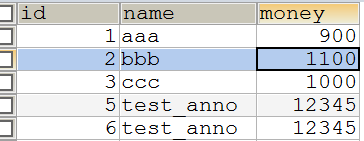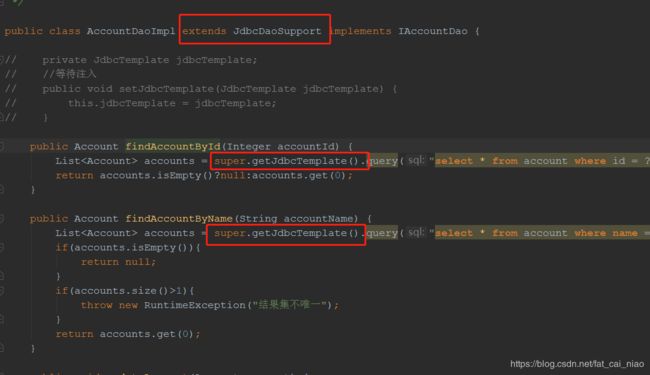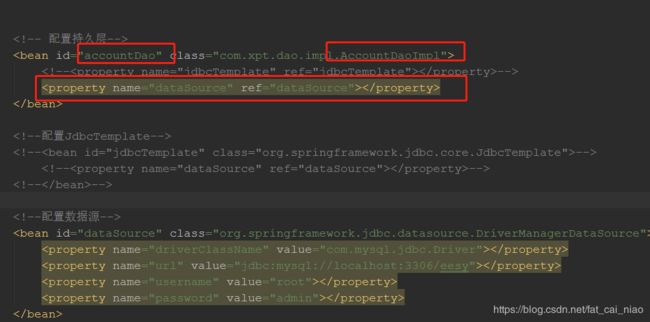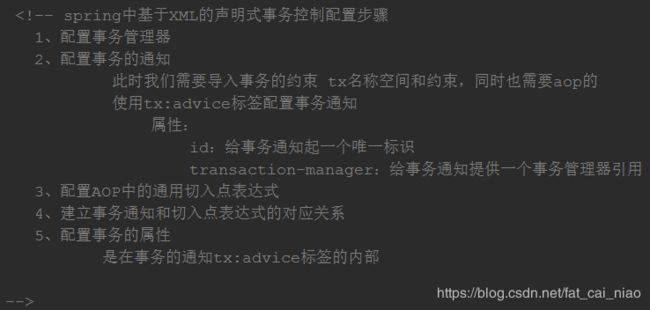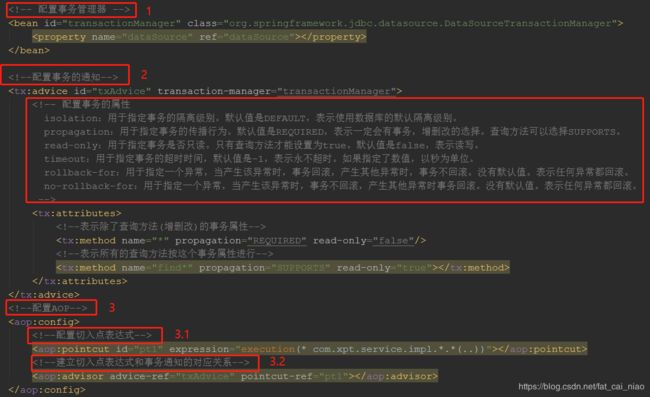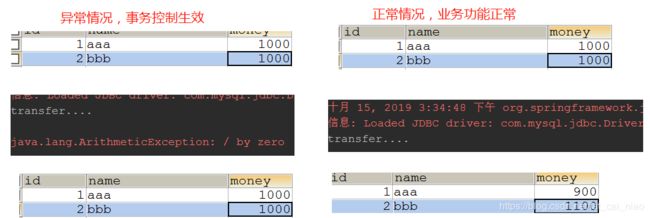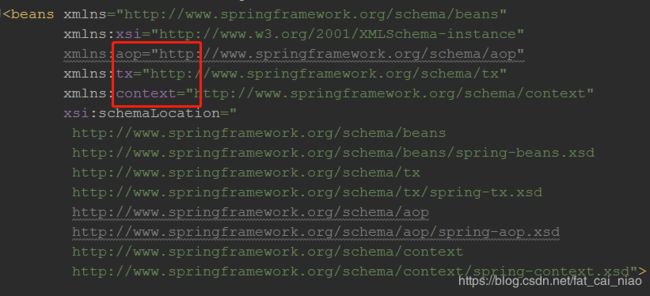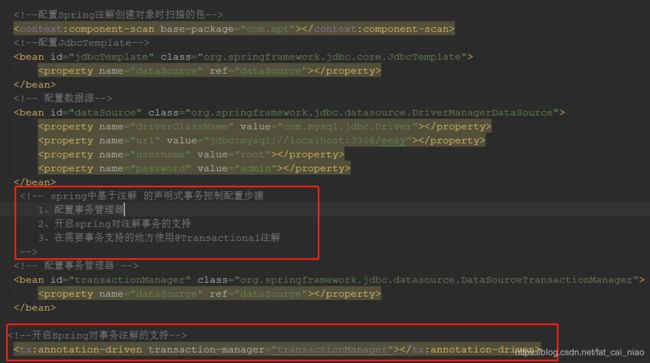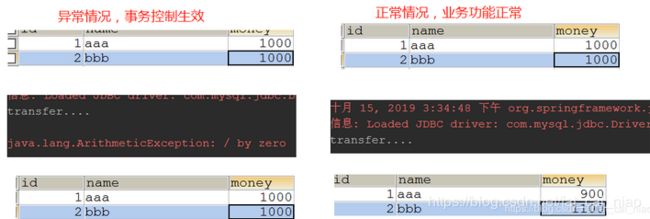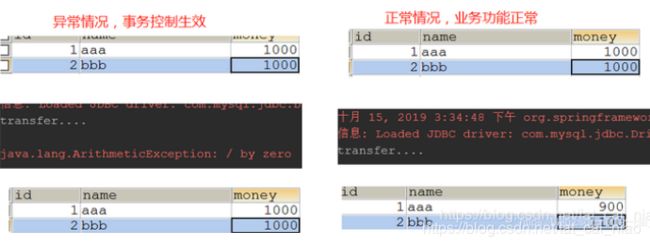spring学习笔记(8):Spring中的template和事务控制
文章目录
- 一、工程准备
- 1.数据库
- 2.pom.xml
- 2.实体类
- 3.JdbcTemplate的最基本的使用
- 3.1代码
- 二、JdbcTemplate
- 1.基于IOC配置的JdbcTemplate使用
- 1.1bean.xml
- 1.2测试类
- 2.实现单表的CRUD
- 3.实现DAO层
- 3.1接口
- 3.2实现类
- 3.3bean.xml
- 3.4测试类
- 4.JdbcDaoSupport
- 三、Spring的事务控制案例的环境搭建
- 1实体类
- 2Dao层
- 2.1接口
- 2.2实现类
- 3业务层
- 3.1接口
- 3.2实现类
- 4bean.xml
- 5测试类
- 5.1暂无事务控制,测试类结果
- 四、基于xml的声明式事务控制
- 1.配置步骤
- 2.测试效果
- 五、基于注解的声明式事务控制配置
- 1bean.xml
- 2Dao层
- 3.业务层(注解事务配置)
- 4.效果
- 5.基于注解和基于xml的事务控制配置对比
- 六基于纯注解的声明式事务控制的配置
- 1.和数据库连接相关的配置类
- 2.和事务相关的配置类
- 3.主配置类
- 4.测试类改造
- 5.效果
- 七、Spring5的新特性
一、工程准备
1.数据库
2.pom.xml
<dependencies>
<dependency>
<groupId>org.springframeworkgroupId>
<artifactId>spring-contextartifactId>
<version>5.0.2.RELEASEversion>
dependency>
<dependency>
<groupId>org.springframeworkgroupId>
<artifactId>spring-jdbcartifactId>
<version>5.0.2.RELEASEversion>
dependency>
<dependency>
<groupId>org.springframeworkgroupId>
<artifactId>spring-txartifactId>
<version>5.0.2.RELEASEversion>
dependency>
<dependency>
<groupId>mysqlgroupId>
<artifactId>mysql-connector-javaartifactId>
<version>5.1.6version>
dependency>
dependencies>
2.实体类
public class Account implements Serializable {
private Integer id;
private String name;
private Float money;
public Integer getId() {
return id;
}
public void setId(Integer id) {
this.id = id;
}
public String getName() {
return name;
}
public void setName(String name) {
this.name = name;
}
public Float getMoney() {
return money;
}
public void setMoney(Float money) {
this.money = money;
}
@Override
public String toString() {
return "Account{" +
"id=" + id +
", name='" + name + '\'' +
", money=" + money +
'}';
}
}
3.JdbcTemplate的最基本的使用
3.1代码
public class JdbcTemplateDemo1 {
public static void main(String[] args) {
//1.准备数据源 spring的内置数据源
DriverManagerDataSource ds = new DriverManagerDataSource();
ds.setDriverClassName("com.mysql.jdbc.Driver");
ds.setUrl("jdbc:mysql://localhost:3306/eesy");
ds.setUsername("root");
ds.setPassword("admin");
//2.创建template对象
JdbcTemplate jt = new JdbcTemplate();
//3.给它设置数据源
jt.setDataSource(ds);
//4.执行操作
jt.execute("insert into account(name,money) values ('csacas',1000)");
}
}
二、JdbcTemplate
1.基于IOC配置的JdbcTemplate使用
1.1bean.xml
<!--配置JdbcTemplate-->
<bean id="jdbcTemplate" class="org.springframework.jdbc.core.JdbcTemplate">
<property name="dataSource" ref="dataSource"></property>
</bean>
<!--配置数据源-->
<bean id="dataSource" class="org.springframework.jdbc.datasource.DriverManagerDataSource">
<property name="driverClassName" value="com.mysql.jdbc.Driver"></property>
<property name="url" value="jdbc:mysql://localhost:3306/eesy"></property>
<property name="username" value="root"></property>
<property name="password" value="admin"></property>
</bean>
1.2测试类
public class JdbcTemplateDemo2 {
public static void main(String[] args) {
//1.获取IOC对象
ApplicationContext ac = new ClassPathXmlApplicationContext("bean.xml");
//2.获取jdbcTemplate对象
JdbcTemplate jt = ac.getBean("jdbcTemplate",JdbcTemplate.class);
//3.执行方法
jt.execute("insert into account(name,money) values ('jdbcTemplate_IOC',1000)");
}
}
2.实现单表的CRUD
public class JdbcTemplateDemo3 {
public static void main(String[] args) {
//1.获取IOC对象
ApplicationContext ac = new ClassPathXmlApplicationContext("bean.xml");
//2.获取jdbcTemplate对象
JdbcTemplate jt = ac.getBean("jdbcTemplate",JdbcTemplate.class);
//3.保存
jt.update("insert into account(name,money) values ('jdbcTemplate_IOC',1000)");
//4.更新
jt.update("update account set name = ?, money = ? where id=?", "test",4444,6);
//5.删除
jt.update("delete from account where id=?",8);
//6.查询所有
List<Account> accounts = jt.query("select * from account where money > ?", new BeanPropertyRowMapper<Account>(Account.class),1000f);
for (Account account : accounts) {
System.out.println(account);
}
//7.查询一个
List<Account> account_1 = jt.query("select * from account where id= ?", new BeanPropertyRowMapper<Account>(Account.class),1000f);
System.out.println(account_1.isEmpty() ? "没有内容" : account_1.get(0));
//8.查询返回一行一列
Long count = jt.queryForObject("select count(*) from account where money > ?",Long.class,1000f);
System.out.println(count);
}
}
3.实现DAO层
3.1接口
public interface IAccountDao {
/**
* 根据Id查询账户
* @param accountId
* @return
*/
Account findAccountById(Integer accountId);
/**
* 根据名称查询账户
* @param accountName
* @return
*/
Account findAccountByName(String accountName);
/**
* 更新账户
* @param account
*/
void updateAccount(Account account);
}
3.2实现类
public class AccountDaoImpl implements IAccountDao {
private JdbcTemplate jdbcTemplate;
//等待注入
public void setJdbcTemplate(JdbcTemplate jdbcTemplate) {
this.jdbcTemplate = jdbcTemplate;
}
public Account findAccountById(Integer accountId) {
List<Account> accounts = jdbcTemplate.query("select * from account where id = ?",new BeanPropertyRowMapper<Account>(Account.class),accountId);
return accounts.isEmpty()?null:accounts.get(0);
}
public Account findAccountByName(String accountName) {
List<Account> accounts = jdbcTemplate.query("select * from account where name = ?",new BeanPropertyRowMapper<Account>(Account.class),accountName);
if(accounts.isEmpty()){
return null;
}
if(accounts.size()>1){
throw new RuntimeException("结果集不唯一");
}
return accounts.get(0);
}
public void updateAccount(Account account) {
jdbcTemplate.update("update account set name=?,money=? where id=?",account.getName(),account.getMoney(),account.getId());
}
}
3.3bean.xml
<bean id="accountDao" class="com.xpt.dao.impl.AccountDaoImpl">
<property name="jdbcTemplate" ref="jdbcTemplate">property>
bean>
3.4测试类
public class JdbcTemplateDemo4 {
public static void main(String[] args) {
//1.获取IOC对象
ApplicationContext ac = new ClassPathXmlApplicationContext("bean.xml");
//2.获取dao对象
IAccountDao accountDao = ac.getBean("accountDao",IAccountDao.class);
//3.调用方法
Account accountById = accountDao.findAccountById(1);
System.out.println(accountById);
}
}
4.JdbcDaoSupport
三、Spring的事务控制案例的环境搭建
- 基于前文JdbcTemplate进行搭建
1实体类
public class Account implements Serializable {
private Integer id;
private String name;
private Float money;
public Integer getId() {
return id;
}
public void setId(Integer id) {
this.id = id;
}
public String getName() {
return name;
}
public void setName(String name) {
this.name = name;
}
public Float getMoney() {
return money;
}
public void setMoney(Float money) {
this.money = money;
}
@Override
public String toString() {
return "Account{" +
"id=" + id +
", name='" + name + '\'' +
", money=" + money +
'}';
}
}
2Dao层
2.1接口
public interface IAccountDao {
/**
* 根据Id查询账户
* @param accountId
* @return
*/
Account findAccountById(Integer accountId);
/**
* 根据名称查询账户
* @param accountName
* @return
*/
Account findAccountByName(String accountName);
/**
* 更新账户
* @param account
*/
void updateAccount(Account account);
}
2.2实现类
public class AccountDaoImpl extends JdbcDaoSupport implements IAccountDao {
public Account findAccountById(Integer accountId) {
List<Account> accounts = super.getJdbcTemplate().query("select * from account where id = ?",new BeanPropertyRowMapper<Account>(Account.class),accountId);
return accounts.isEmpty()?null:accounts.get(0);
}
public Account findAccountByName(String accountName) {
List<Account> accounts = super.getJdbcTemplate().query("select * from account where name = ?",new BeanPropertyRowMapper<Account>(Account.class),accountName);
if(accounts.isEmpty()){
return null;
}
if(accounts.size()>1){
throw new RuntimeException("结果集不唯一");
}
return accounts.get(0);
}
public void updateAccount(Account account) {
super.getJdbcTemplate().update("update account set name=?,money=? where id=?",account.getName(),account.getMoney(),account.getId());
}
}
3业务层
3.1接口
/**
* 账户的业务层接口
*/
public interface IAccountService {
/**
* 根据id查询账户信息
* @param accountId
* @return
*/
Account findAccountById(Integer accountId);
/**
* 转账
* @param sourceName 转成账户名称
* @param targetName 转入账户名称
* @param money 转账金额
*/
void transfer(String sourceName, String targetName, Float money);
}
3.2实现类
public class AccountServiceImpl implements IAccountService{
private IAccountDao accountDao;
public void setAccountDao(IAccountDao accountDao) {
this.accountDao = accountDao;
}
public Account findAccountById(Integer accountId) {
return accountDao.findAccountById(accountId);
}
public void transfer(String sourceName, String targetName, Float money) {
System.out.println("transfer....");
//2.1根据名称查询转出账户
Account source = accountDao.findAccountByName(sourceName);
//2.2根据名称查询转入账户
Account target = accountDao.findAccountByName(targetName);
//2.3转出账户减钱
source.setMoney(source.getMoney()-money);
//2.4转入账户加钱
target.setMoney(target.getMoney()+money);
//2.5更新转出账户
accountDao.updateAccount(source);
// int i=1/0;
//2.6更新转入账户
accountDao.updateAccount(target);
}
}
4bean.xml
<beans xmlns="http://www.springframework.org/schema/beans"
xmlns:xsi="http://www.w3.org/2001/XMLSchema-instance"
xsi:schemaLocation="http://www.springframework.org/schema/beans
http://www.springframework.org/schema/beans/spring-beans.xsd">
<bean id="accountService" class="com.xpt.service.impl.AccountServiceImpl">
<property name="accountDao" ref="accountDao">property>
bean>
<bean id="accountDao" class="com.xpt.dao.impl.AccountDaoImpl">
<property name="dataSource" ref="dataSource">property>
bean>
<bean id="dataSource" class="org.springframework.jdbc.datasource.DriverManagerDataSource">
<property name="driverClassName" value="com.mysql.jdbc.Driver">property>
<property name="url" value="jdbc:mysql://localhost:3306/eesy">property>
<property name="username" value="root">property>
<property name="password" value="admin">property>
bean>
beans>
5测试类
@RunWith(SpringJUnit4ClassRunner.class)
@ContextConfiguration(locations = "classpath:bean.xml")
public class AccountServiceTest {
@Autowired
private IAccountService as;
@Test
public void testTransfer(){
as.transfer("aaa","bbb",100f);
}
}
5.1暂无事务控制,测试类结果
四、基于xml的声明式事务控制
1.配置步骤
2.测试效果
五、基于注解的声明式事务控制配置
1bean.xml
2Dao层
3.业务层(注解事务配置)
4.效果
5.基于注解和基于xml的事务控制配置对比
六基于纯注解的声明式事务控制的配置
主要回顾一下如何进行纯注解的配置
1.和数据库连接相关的配置类
public class JdbcConfig {
@Value("${jdbc.driver}")
private String driver;
@Value("${jdbc.url}")
private String url;
@Value("${jdbc.username}")
private String username;
@Value("${jdbc.password}")
private String password;
@Bean(name = "jdbcTemplate")
public JdbcTemplate createJdbcTemplate(DataSource dataSource){
return new JdbcTemplate(dataSource);
}
@Bean(name = "dataSource")
public DataSource createDataSource(){
DriverManagerDataSource ds = new DriverManagerDataSource();
ds.setDriverClassName(driver);
ds.setUrl(url);
ds.setUsername(username);
ds.setPassword(password);
return ds;
}
}
2.和事务相关的配置类
public class TransactionConfig {
/**
* 用于创建事务管理器对象
* @param dataSource
* @return
*/
@Bean(name = "transactionManager")
public PlatformTransactionManager createPlatformTransactionManager(DataSource dataSource){
return new DataSourceTransactionManager(dataSource);
}
}
3.主配置类
@Configuration
@ComponentScan("com.xpt")
@Import({JdbcConfig.class,TransactionConfig.class})
@PropertySource("jdbcConfig.properties")
@EnableTransactionManagement//
public class SpringConfiguration {
}
4.测试类改造
@RunWith(SpringJUnit4ClassRunner.class)
@ContextConfiguration(classes = SpringConfiguration.class)
public class AccountServiceTest {
@Autowired
private IAccountService as;
@Test
public void testTransfer(){
as.transfer("aaa","bbb",100f);
}
}
